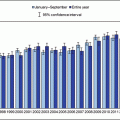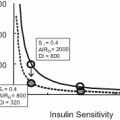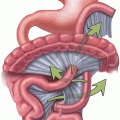Fig. 9.1
a The retrogastric tunnel extends from the lower medial aspect of the right crus of the diaphragm toward the angle of His. b The tunnel is best created under direct visualization or by careful blind passage of a blunt instrument by surgeons with significant experience of the anatomy. c The end-tag of the band is brought up to meet the retrogastric grasper or band passer and is pulled through
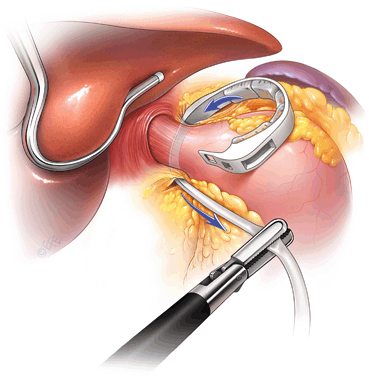
Fig. 9.2
The band tubing is then grasped and the band is retracted into appropriate position
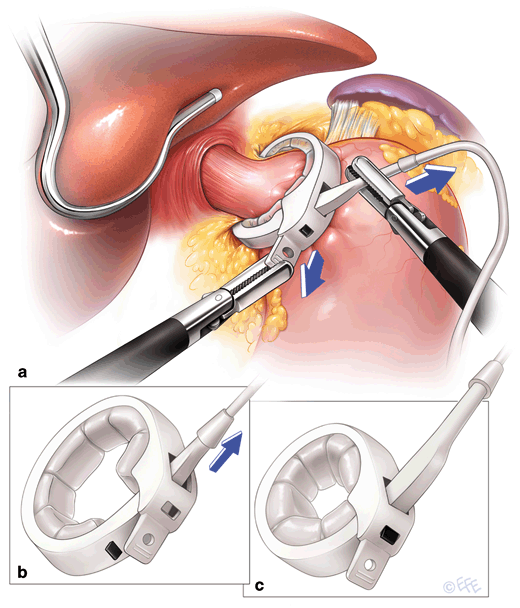
Fig. 9.3
a The band is then locked into position through the use of counter tension applied by graspers in the direction of the arrows. b The band is in the unlocked position and the arrow illustrates the force vector required to lock the band in place. c The band is now in the locked position

Fig. 9.4
An anterior gastro-gastric fundoplication is made in order to prevent herniation of the stomach through the band. Permanent suture is used to secure the band in place
The tubing is brought out through the abdominal wall. The distal end of the band tubing is then attached to the port. The port is fixed to the anterior fascia to allow it to remain flat against the fascia and prevent flipping of the port. The excess tubing is placed back into the abdomen.
Currently, there are two brands of adjustable gastric bands which are FDA approved for use in the USA. Both are equally safe and effective [8].
Mechanism of Action
The LAGB has been clearly shown to reduce energy intake [9, 10]. The mechanism of action was originally attributed to restriction; however, several studies have shown minimal to no delayed gastric emptying. If weight loss were due to generating enhanced difficulty in attaining desired meal size alone, strong evolutionary mechanisms to maintain energy balance would likely produce shortened post-meal satiety and resultant grazing between meals. The negligible delay in gastric emptying and prolonged satiety noted by LAGB patients suggests stronger additional mechanisms at work. Greater early satiation and a longer period of satiety appear to be essential to the ability of the band to produce sustained weight loss. This was demonstrated by a double-blind randomized, controlled trial with the band either correctly adjusted or empty. When the band was correctly adjusted, subjects were less hungry after a 12-h fast and found a small meal more satisfying.[11]. Glucose, insulin, ghrelin, and leptin levels in this study did not vary between optimal and decreased, suboptimal restriction.
Esophageal motility has been shown to be well preserved in LAGB patients with a successful outcome. One study showed that varying the volume between optimal, 20 % under, and empty produced few changes in esophageal motility [12]. The authors also noted repetitive esophageal contractions in 40 % of swallows in optimally adjusted LAGB patients. Repetitive contractions appear to be of functional importance as they reflect the esophageal response to decreased bolus transport across the band .
Postoperative management is affected by achieving appropriately adjusted bands, carefully avoiding either a lack of restriction or excessive restriction with obstructive symptoms.
Band Adjustments
Band adjustments are typically performed in the office with or without the aid of fluoroscopy. Prior to each band fill, a detailed history is required including current food choices, hunger between meals, portion sizes, symptoms of regurgitation, night cough, and any discomfort with eating should be noted. Patients need to comprehend the importance of early satiation and prolonged satiety in permitting 50 % reduction in daily energy intake [13]. This may be accomplished by eating slowly and increasing the time spent for chewing to avoid obstructive symptoms. One bite of food should be chewed almost 20 times until mushy. Once swallowed, at least 30 s to a minute should pass before another small bite is placed into their mouth. The standard portion size is approximately 1–1.5 decks of cards (or the palm of your hand) consumed slowly over approximately 20–30 min. Patients are recommended to consume 3–4 small meals a day .
The band should be adjusted to the “green zone” based on symptomatology (Fig. 9.6). If patients are hungry between meals and needing larger portions, they are likely in the yellow zone and an adjustment to add fluid into the band is needed. If they are having good portion control with feelings of satisfaction and lack of hunger, they are in the green zone and no adjustment is needed. Lastly, if they are experiencing symptoms of regurgitation, discomfort while eating, or night cough, they are in the red zone and will require an adjustment to remove fluid from the band. Red zone patients typically have poor weight loss and make poor food choices such as high calorie liquids as they are too tight and unable to tolerate healthy optimal foods.
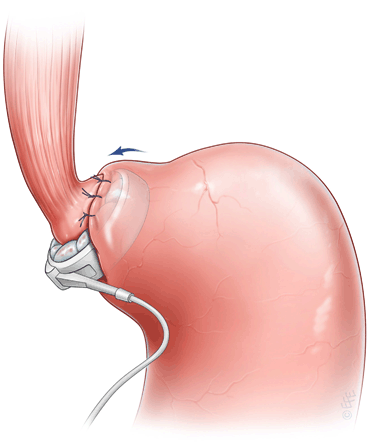
Fig. 9.5
The final position of the band should be from the 2 o’clock to 8 o’clock angle for proper placement
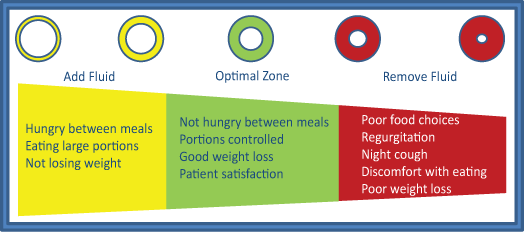
Fig. 9.6
The green zone chart allows patients to understand what a correctly adjusted band should feel like
Adjustments are performed using sterile technique. Often a small amount of lidocaine is used to numb the skin above the port. A Huber needle is always used to adjust the band as it has a beveled tip to prevent coring of the port with repeated adjustments. Saline fluid is either added or removed as needed. Patients are usually asked to drink a couple of glasses of water prior to leaving the office to ensure they are not too tight. Patients are typically asked to return for an adjustment when they are no longer in the green zone.
Indications and Contraindications
Criteria for patient selection for weight loss surgery are based on guidelines of the National Institute of Health and national surgical societies. The American College of Surgeons, Society of Gastrointestinal Endoscopic Surgeons (SAGES) and The American Society of Bariatric Surgeons have all offered guidelines for patient selection.
The National Heart, Lung, and Blood Institute in cooperation with The National Institute of Diabetes and Digestive and Kidney Diseases of the National Institutes of Health (NIH) compiled recommendations on patient selection for bariatric surgery in 1998. This report updated the NIH Consensus Development Conference Statement of 1991. The 1998 recommendations were published as the Clinical Guidelines on the Identification, Evaluation, and Treatment of Overweight and Obesity in Adults: The Evidence Report [14]. The NIH made the recommendation that weight loss surgery is an option for carefully selected patients with clinically severe obesity (Body Mass Index > 40 or > 35 with comorbid conditions). This is after less invasive weight loss methods have failed and the patient remains at a high risk for obesity-related morbidity or mortality. The report also summarized available data regarding weight reduction after the age of 65. The potential benefits of weight reduction for daily functioning, decreased risk of future cardiovascular events, and the patient’s motivation for weight reduction should be thoroughly evaluated. Any weight reduction program should minimize the likelihood of adverse effects on bone health and overall nutritional status in the older adult.
The America College of Surgeons published recommendations for “Recommendations for Facilities Performing Bariatric Surgery” (ST-34) [15]. They point out that bariatric surgical procedures are not for cosmesis, but for prevention of negative health consequences of morbid obesity. Patients must be committed to both the appropriate preoperative evaluation and the long-term postoperative medical management. Patients must have a full understanding of the potential complications of the procedure.
The American Society of Gastrointestinal Endoscopic Surgeons (SAGES) issued “The SAGES Guidelines for Laparoscopic and Conventional Surgical Treatment of Morbid Obesity.” The specific criteria for surgical therapy are for people with a body mass index (BMI) of greater than 40 kg/m2 or a BMI greater than 35 kg/m2 with significant comorbidities, with evidence that dietary attempts at weight control have been ineffective.
The American Society of Bariatric Surgeons (ASBS) emphasize that surgical treatment should be offered to patients who are severely obese, well informed, motivated, and have acceptable operative risks. Anyone with psychopathology that jeopardizes an informed consent and cooperation with long-term follow-up may be poor surgical candidates. Central obesity and obesity-associated functional impairments such as musculoskeletal or neurologic or body size problems precluding or severely interfering with employment, family function, and ambulation may be best served by surgical treatment.
There are six categories defined by the NIH recommendations that assist in determining appropriateness for surgical weight loss: Age, BMI, family history of significant comorbid medical conditions related to morbid obesity, the development of significant comorbid health conditions related to morbid obesity, failure of established weight control programs to achieve sustained weight loss, and mental competence to give informed consent to participate in long-term follow-up programs.
Optimal age range for surgical intervention is between 18- and 65-years-old. Younger patients may be considered if they require rapid weight reduction for resolution of obesity-related life-threatening comorbid health conditions. For patients who are older than 65 years, the expectation of improved life expectancy or quality of life should outweigh the risk of surgery. Patients should have a body mass index > 40 kg/m2 or a body mass index > 35 and < 40 kg/m2 with the presence of significant comorbid conditions related to morbid obesity.
According to the NIH, weight loss surgery is indicated for people with a high risk for obesity-associated morbidity or mortality. As such, surgery may be indicated in for a person with a strong family history of obesity-related health conditions. For patients who have already developed significant medical conditions related to morbid obesity, weight loss surgery may cure or significantly improve comorbid diseases and prevent their associated morbidity and mortality. Examples of significant medical conditions include diabetes mellitus, sleep apnea, high cholesterol, the metabolic syndrome, or infertility.
Surgical treatment of morbid obesity is appropriate only in patients in whom success with established weight loss programs seems unlikely. In order to qualify, patients must have made sustained efforts in organized weight loss programs over a substantial time period. Appropriate programs include a variety of commercial weight loss programs, caloric restriction diets directed by nutritionists, dieticians, or diabetes centers, or intense exercise programs directed by an exercise therapist or other qualified professional.
Patients must be mentally competent to give informed consent. Patients with a significant psychosis may not be able to adhere to the prolonged follow-up programs.
In 2011, the FDA approved the use of the lap band in patients with BMIs of 30–34.9 with one significant obesity-related comorbidity, or patients with BMIs of 35–39.9 with no comorbidities. This decision was made after review of studies showing the safety and efficacy of the lap band in lower BMI patients, providing durable weight loss and significant comorbidity improvement or resolution [16, 17]. Although currently insurance companies follow the original guidelines and have not adopted coverage of the lap band procedure at this lowered BMI, it is an option for patients requiring sustainable weight loss for comorbidity resolution or improvement, and will significantly impact comorbidity prevention.
Weight Loss Outcomes
Although weight loss after LAGB surgery is not as rapid as seen with Roux-Y-gastric bypass or sleeve gastrectomy, weight loss with the band is progressive over approximately 2 years and appears durable. One study demonstrated that after reaching peak weight loss at 2 years, there is a high degree of stability of the weight loss status through the next 13 years [18]. Randomized controlled trials have demonstrated LAGB to be superior to conventional nonsurgical weight-loss programs for sustained weight loss and diabetes management [19–21].
The first adjustable band was approved by the US Food and Drug Administration in 2001. As the LAGB has been available for use outside the USA since 1993, there are much longer follow-up durations. An Italian series has the longest follow-up and details of 1791 consecutive patients with a mean excess weight loss of 50 % 12 years after LAGB [19]. Procedures such as RYGB and sleeve gastrectomy have better early weight loss but usual partial weight regain 2–5 years after surgery [22, 23].Although LAGB weight loss takes a longer course to reach a maximum, at 5 years LAGB patients achieve the comparable weight loss results of 55 % of excess weight loss versus 58 % with Gastric Bypass . [22].
Health Outcomes
Diabetes
The risk of developing type 2 diabetes increases with the degree and duration of obesity and is more common with a central weight distribution . The associated decrease in insulin sensitivity seen with central obesity correlates with impaired glucose tolerance, dyslipidemia, and systemic hypertension and increased cardiovascular risk. The beneficial effect of weight reduction on control of type 2 diabetes has been known for some time and studies have shown benefit even from modest weight reduction [24, 25].
At 2 years after placement of the lap band, 50 % of those with type 2 diabetes mellitus will no longer require diabetic therapy [21, 26]. The sooner the intervention to time of diabetic onset, the higher the remission rate, likely due to the maintained β-cell function [27]. The improvement in insulin sensitivity is correlated with weight loss, but improvement in β-cell function is not. The percentage of excess weight lost also affects the likelihood of remission of type 2 diabetes .
A randomized controlled study published by Dixon in 2008 clearly demonstrated the effectiveness of Lap band versus conventional medical therapy for diabetes resolution with 73 % versus 13 % resolution seen in the surgical group at 2 years [21].
The recent meta-analytic review of the two most commonly used LAGBs revealed a 60 % resolution of diabetes, and significant improvements of the other parameters of the metabolic syndrome, clearly demonstrating the effectiveness of this device in comorbidity resolution as well as weight loss [8].
Asthma/Sleep Apnea
Morbidly obese adults have a high rate of asthma, and major reductions in asthma severity occur after weight loss. This is likely due in part to the prevention of gastroesophageal reflux. One study examining the effect of LAGB on asthma symptoms found significant improvements in all aspects of asthma assessed. These included severity, daily impact, medications needed, hospitalization, sleep, and exercise [28].
Stay updated, free articles. Join our Telegram channel

Full access? Get Clinical Tree



